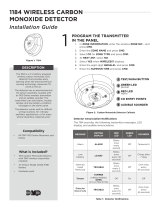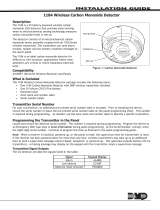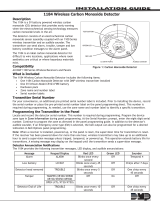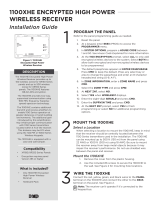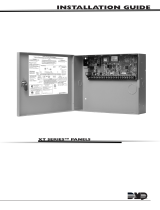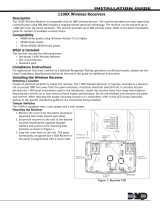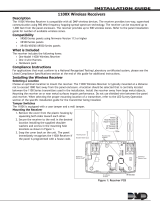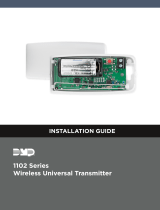Page is loading ...

1184 WIRELESS CARBON
MONOXIDE DETECTOR
Installation Guide
Figure 2: Carbon Monoxide Detector Callouts
1
TEST/HUSH BUTTON
2
GREEN LED
Normal
3
RED LED
Alarm
4
CO ENTRY POINTS
5AUDIBLE SOUNDER
1
2
3
4
5
PROGRAM THE TRANSMITTER IN THE PANEL
1. In ZONE INFORMATION, enter the wireless ZONE NO: ‑ and press
CMD.
2. Enter the ZONE NAME and press CMD.
3. Select CO for ZONE TYPE and press CMD.
4. At NEXT ZN?, select NO.
5. Select YES when WIRELESS? displays.
6. Enter the eight‑digit SERIAL#:- and press CMD.
7. Enter the SUPRVSN TIME and press CMD.
DESCRIPTION
The 1184 is a 3 V battery powered
wireless carbon monoxide (CO) detector
that provides early warning when the
electrochemical sensing technology
measures CO levels in the air.
The detector has an electrochemical CO
sensor assembly coupled with an 1100
Series wireless transmitter and an audible
sounder. The transmitter can send alarm,
trouble, tamper, and low battery condition
messages to the alarm panel.
The detector works well for dicult
wiring locations, for critically aesthetic
applications, or for areas where hazardous
materials exist.
Compatibility
• All DMP 1100 Series Receivers and
Panels.
What is Included?
• 1184 Carbon Monoxide Detector with
DMP wireless transmitter installed
• 3V lithium Model CR123‑FIRE battery
• Hardware pack
• Zone name and number label
• Serial number labels
1
Detector Annunciation Notifications
The 1184 provides the following transmitter messages, LED display, and
audible annunciations:
Message Keypad Display Red LED Green LED Sounder
Alarm ALARM
Blinks once every
second
O Temporal 4
Low battery LO BAT
Blinks once every
45 seconds
O
Chirps after
7 days
Detector
Head
Removed
TROUBLE
Blinks once every
5 seconds
O
One chirp
every
45 seconds
Tamper
TAMPER
(XR150/XR550)
O On O
OPEN
(XTL/XT30/XT50)
Detector
End of Life
TROUBLE
Blinks once every
10 seconds
O
One chirp
every
45 seconds
Figure 1: Wireless Carbon
Monoxide Detector

SELECT THE PROPER LOCATION
(LED SURVEY OPERATION)
Install the transmitter away from large metal objects which impair wireless performance. For the LED
Survey Operation complete the following steps before proceeding:
1. Use a separate 1100 Series Transmitter for the LED Survey Operation such as an 1106 since the 1184
transmitter PCB is not visible
2. Find the survey button on the 1106 transmitter PCB and the survey LED near the survey button
location. The transmitter PCB Red Survey LED turns on whenever data is sent to the receiver then
immediately turns o when the receiver acknowledgement is received.
3. Press and release the tamper switch to send data to the receiver to confirm operation.
Confirmed: If communication is confirmed, for each press or release of the tamper switch the
LED blinks immediately on and immediately o.
Faulty: If communication is faulty, the LED remains on for about 8 seconds or flashes multiple
times in quick succession. Relocate the transmitter or receiver until the LED immediately turns
o indicating the transmitter and receiver are communicating properly.
4. Test the communication between the control panel and the detector using the panel walk test
feature. See Test the Detector Alarm.
General Location Guidelines
In addition to NFPA 720, use the following location guidelines to optimize performance from the CO
detector:
• Install ceiling‑mounted detectors at least 12 inches from any wall
• Install wall‑mounted detectors at least as high as the light switch and 6 inches below the ceiling.
• Mount the detector on a firm permanent surface
• Locate the detector in environmentally controlled areas where the temperature does not exceed 104° F
(40° C) or drop below 32° F (0° C).
• When mounting to suspended ceiling tile, the tile must be secured with the appropriate fastener to
prevent tile removal
• Install in the vicinity of flame‑fueled appliances, but no closer than 10 feet.
• Keep detectors away from vents and the reach of children and pets.
INSTALL THE DETECTOR
When setting up a wireless system, it is recommended to program zones and connect the wireless receiver
before installing batteries in the transmitters.
1. Use the two screws
provided to mount the
base in the location
previously surveyed for
proper communication.
2. Use the alignment notch
on the lip of the mounting
base as a guide to align
the detector with the
alignment tabs.
3. Insert the detector into the
mounting base and turn
clockwise approximately 15
degrees to snap into place.
To remove the detector from the mounting base, grasp the detector and turn it counterclockwise
approximately 15 degrees. The detector snaps o of the mounting base. See Figure 3.
A
Mount the base using the screws
B
Align notch and tab
C
Turn clockwise
A
A
B
B
C
Figure 3: Exploded View of CO Detector
2
3

INSTALL OR REPLACE THE BATTERIES
Observe polarity when installing the battery. Use only 3.0 V lithium batteries, DMP Model CR123‑FIRE or
Panasonic Model CR123A.
Note: When setting up a wireless system, it is recommended to program zones and connect the
receiver before installing batteries in the transmitters.
1. Remove the detector from the mounting base. See the final section of Install the Detector.
2. The battery is located on the inside of the detector. The detector is supplied with a pre‑installed
battery. During the initial installation simply remove the battery pull tab to begin operation.
3. If replacing the battery, remove the old battery and dispose of properly.
4. Observing correct polarity, insert the new 3V lithium battery into the battery compartment and
replace the cover. Use only new batteries when replacing old ones.
5. Reattach the detector to the mounting base.
6. Test the detector. See Test the Detector Alarm.
Caution: Properly dispose of used batteries. Do not recharge, disassemble, heat above 212°F
(100°C), or incinerate. Risk of fire, explosion, and burns.
TEST THE DETECTOR ALARM
Wireless Communication
The control panel alarm and all auxiliary functions should be verified for a complete test of the system.
See the panel programming guide for additional information.
1. To conduct the Walk Test, reset the control panel. From the keypad, enter the code 8144
(WALK). The keypad displays WALK TEST. Select STD for Standard Walk Test. Refer to the panel
programming guide for complete information on Walk Test operation.
2. Insert a small screwdriver into the Test hole on the front of the detector to activate the test, sound
the detector’s audible and send a message. Verify that the walk test trip counter increments to
indicate a successful test.
3. Select END to stop the Walk Test. When the Walk Test ends or a 20‑minute time‑out expires, a final
Sensor Reset occurs. Faulted zones then display on the keypad.
Detector Sensitivity
Before testing, be sure to notify the central station to avoid false alarms.
1. With a small screwdriver, press and hold the recessed Test switch on the detector for approximately
2 seconds. The detector will temporarily sound an alarm and the red LED will illuminate.
2. Within a few seconds the green LED will start to blink rapidly indicating the detector is in functional
test mode awaiting gas entry.
3. Spray a very small amount of Solo
TM
brand C6 canned CO, available at most local security
distributors or online, into one of the 3 small gas entry holes located on the top center of the
detector.
Upon successful gas entry and if functioning properly, the detector will alarm by sounding
in a Temporal 4 pattern with the red LED blinking. An alarm signal will be sent to the panel
providing verification of alarm signal.
The alarm condition at the detector will time out in 20 to 60 seconds or when the CO gas has
cleared.
If gas entry is unsuccessful, the test will time out after 27 seconds.
4. Reset the panel as needed.
4
5

FCC INFORMATION
This device complies with Part 15 of the FCC Rules. Operation is subject to the following two conditions:
1. This device may not cause harmful interference, and
2. This device must accept any interference received, including interference that may cause undesired operation.
Changes or modifications made by the user and not expressly approved by the party responsible for compliance
could void the user’s authority to operate the equipment.
Note: This equipment has been tested and found to comply with the limits for a Class B digital device, pursuant
to part 15 of the FCC Rules. These limits are designed to provide reasonable protection against harmful
interference in a residential installation. This equipment generates, uses and can radiate radio frequency
energy and, if not installed and used in accordance with the instructions, may cause harmful interference
to radio communications. However, there is no guarantee that interference will not occur in a particular
installation. If this equipment does cause harmful interference to radio or television reception, which
can be determined by turning the equipment o and on, the user is encouraged to try to correct the
interference by one or more of the following measures:
• Reorient or relocate the receiving antenna.
• Increase the separation between the equipment and receiver.
• Connect the equipment into an outlet on a circuit dierent from that to which the receiver is connected.
• Consult the dealer or an experienced radio/TV technician for help.
Note: The 1100 Series wireless system is a two‑way supervised wireless design. It is compliant with FCC rules
as they pertain to 900 MHz Spread Spectrum devices. In rare instances it has been observed that certain
900 MHz cordless telephones may occasionally experience a clicking sound on the telephone while
in use. If this occurs, it may be resolved by selecting a dierent channel on the cordless telephone, or
replacing the cordless phone with a dierent brand or model of 900 MHz telephone or other cordless
telephone.
To comply with RF exposure requirements, a minimum distance of 20cm must be maintained between the antenna and
all persons.
INDUSTRY CANADA INFORMATION
This device complies with Industry Canada Licence‑exempt RSS standard(s). Operation is subject to the following two
conditions:
1. This device may not cause interference, and
2. This device must accept any interference, including interference that may cause undesired operation of the
device.
Le présent appareil est conforme aux CNR d’Industrie Canada applicables aux appareils radio exempts de licence.
L’exploitation est autorisée aux deux conditions suivantes:
1. L’appareil ne doit pas produire de brouillage, et
2. L’utilisateur de l’appareil doit accepter tout brouillage radioélectrique subi, même si le brouillage est susceptible
d’en compromettre le fonctionnement.
Designed, engineered, and
manufactured in Springfield, Missouri
using U.S. and global components.
© 2019 Digital Monitoring Products, Inc.
LT-1196 19515
INTRUSION • FIRE • ACCESS • NETWORKS
2500 North Partnership Boulevard
Springfield, Missouri 65803‑8877
800.641.4282 | DMP.com
1184 WIRELESS CARBON
MONOXIDE DETECTOR
Patents
U.S. Patent no. 7,239,236
Certifications
California State Fire Marshal (CSFM)
FCC Part 15: CCKPC0104
New York City 1100 Series Wireless (FDNY COA #6167)
Industry Canada: 5251A‑PC0104
Underwriters Laboratory (UL) Listed
ANSI/UL 2075 Gas and Vapor Detectors and Sensors
Specifications
Sensor Life Expectancy Minimum of 3 years, maximum of 6 years
Battery
Life Expectancy Minimum of 2 years (normal operation)
3 V Lithium CR123‑FIRE
Low Battery 2.7 V
Frequency Range 905 ‑ 924 MHz
Dimensions 5.8” x 2.2”
(14.3 cm x 6.1 cm)
Color White
/
